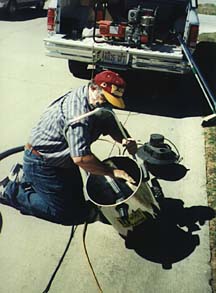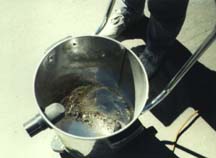Environmental Information for Sweeping Professionals |
Port of Seattle Study on High Efficiency Sweepers
Sweeping up fines could save $16 million over the cost of previous stormwater runoff control solutions.One of the latest sweeping studies involves the 250 acre expansion of a container storage facility by the Port of Seattle. The yard at the proposed site, as well as that of the current location, is 100% paved. At the site, containers are taken off of ships, then moved around, stacked, put onto trailers, etc. Plus, semi trucks bring in containers and leave with full ones. The Port facility is a major shipping nexus of the west coast, and so is a very active operation. As part of their expansion requirements, the Port was faced with an $18 to $20 million stormwater control cost. For this type of expansion, one of the best management practices recommended by the Washington State Department of Ecology (WDOE) is the installation of huge underground boxes, called 'wet vaults.' These are designed to catch stormwater runoff and then settle it. Because of the cost, the Port of Seattle hired Roger Sutherland, of Kurahashi and Associates, Inc. to conduct a study. Sutherland's mandate was to see if an alternative to the wet vaults might work just as well, but cost less. "We collected 2 months worth of data," said Sutherland, "which is the accumulation of sediments on an existing yard almost identical to the proposed expansion." A Seattle stormwater consultant, Gary Minton of Resource Planning Associates, hand-vacuumed the sedimentation that collected at 9 test sweeping sites, each 2,000 square feet in size. At varying frequencies, ranging from weekly to every four weeks, he went out and collected what was on the pavement surface at the various accumulation sites, using a hand broom and a shop vac. That provided the information on how rapidly material accumulates on the pavement after each time it is hand cleaned. During this two month time frame, eight significant rainfall events occurred, and their depths over time were recorded. "We used our SIMPTM computer model," continued Sutherland, "to evaluate whether a street sweeping technology can be competitive with [the pollution load that can be collected by] the wet vaults. This model uses the data we collected in Las Vegas, NV and Centralia, IL, using the advanced technology EnviroWhirl sweeper's ability to pick up street dirt. We have conducted several studies on this machine, and have found it to be far superior to any other sweeper in the marketplace. Sweeping can be more effective than wet vaults at removing difficult pollutants like dissolved metals."Through the real data collected, along with the results of the computer modeling study that went along with it, the conclusion is that high efficiency pavement sweeping, conducted on a weekly basis in conjunction with annual catch basin cleaning, can be, and appears to be, competitive with the wet vaults. The wet vault appears to be more efficient than the net result of the sweeping along with traditional catch basins. However, when it is understood that there is a soluble amount of certain types of pollutants, like metals, that exist in the material that's lying on the pavement surface in a dry format, it appears that the sweeping can be just as competitive as the wet vault, if not more so, when it comes to removing these very difficult pollutants like dissolved metals. 
"The bottom line of the results from this model study is that when the large wet vault concept is compared to weekly sweeping (along with annual catch basin cleaning), then the wet vaults have a 90% reduction in annual Total Suspended Solids (TSS) washoff by stormwater runoff. The sweeping/catch basin concept has a TSS reduction of 65% annually. However, in total phosphorus removal the two methods appear to be close, at 45% annually for wet vaults and with sweeping/catch basins at 55%. Wet vaults are projected to remove 80% of lead annually, with the sweeper/catch basin technology reducing it by 60% annually. And with zinc, which tends to be a more dissolved metal, wet vaults are projected to remove 45% annually and sweeping/catch basins at 50%. All of these reductions are in relationshiup to an annual rainfall simulation with no control assumed to be in place. "The answer appears to be 'Why spend $18 million to install a wet vault when, over a life cycle basis, the sweepers can be purchased and operated for about $2 million?' We think the results of this study may establish a direction for high efficiency street sweeping, especially since the empirical results show it to be better than some of the other traditional Best Management Practices (BMPs) which have historically been used and are therefore grandfathered in." Stan Ciuba, an environmental engineer with the WDOE, is involved with the decision on behalf of that agency. As part of his job, Ciuba is currently working on an update to the Stormwater Management Manual, which will then become the new Washington State stormwater manual. "Our requirement at WDOE is that the Port of Seattle will have to install appropriate BMP's to control pollutants and runoff," said Ciuba. "That's why they're considering the EnviroWhirl [now Schwarze EV-series] sweeper. The remaining pollutants may need just some basic additional cost-effective best management practices. What that will be has yet to be determined. We have not yet decided, between the Port of Seattle and Ecology, what will be an acceptable BMP for what remains after sweeping. They're talking about using some efficient catch basin technology, as opposed to wet vaults, and we're also looking into catch basin inserts, as a newer technology for removing the pollutants - mostly suspended solids - that are left. "The Port's study showed that the EnviroWhirl sweeper removed more of the soluble pollutants than the wet vault, and that's all to the good. However, one of the concerns is that, although sweeping may have been shown to be efficient for some particles, it could only get to a certain percentage of the yard. I think in one section of the yard it can only get to about 8-10%. Sweeping is also not as effective during rainfall conditions, at which time some pollutants may be discharged. So it's that safety net, and the loading that would be discharged during those times when the sweeper is either not effective or not available, that we have to look at for additional pollutant control. "The Port is looking for a more cost-effective approach, and nobody could argue with that. We have to look at it from the standpoint of residual pollutants, ones that remain after applying the appropriate BMPs and that are acceptable in terms of water quality impacts." Dave Torseth is an engineer with the Port of Seattle, and has been working closely on the Port's expansion plan alternatives. "Based upon the study by Kurahashi and Associates," said Torseth, "the Port of Seattle feels comfortable in our proposal for using an EnviroWhirl technology machine as a BMP. We're now in the position of trying to make the Washington State Department of Ecology (WDOE) feel comfortable with it. "The Port of Seattle is pretty convinced that the EnviroWhirl technology represents a significant leap in terms of what the sweeping industry has to offer, and that's why we've gone as far as we have. In the demonstration we saw in September of 1996, the machine did a pretty amazing job of picking up the particulates. It did a good job on both wet and dry pavement. The biggest issue we're facing with the agencies is that they're not that familiar with it yet, so they're not as comfortable with what the machine has to offer. As it becomes accepted throughout the industry, that will help with places [like government agencies]. From what we have seen, and from the results indicated in the study by Kurahashi and Resource Planning revealed, we think this project merits the use of one, and perhaps two Schwarze EV-series sweepers, as soon as we can win approval from Ecology [WDOE]. "There are two issues going on [regarding WDOE's hesitation]. One is that we're trying to compare this new sweeping technology against a wet vault alternative, and there's some question about what a wet vault really does. I think we've done a good job of proving what an EnviroWhirl sweeper will do, but there doesn't seem to be as much data on wet vaults. Problem number two is that WDOE is still concerned about other contaminant-type issues that are normally considered for BMPs, such as oil and grease removal. The Port didn't feel these were appropriate. The WDOE now indicates it may want us to expand our investigation to include these other pollutants. We're talking through the issues right now." Roger Sutherland, P.E., is now president of Pacific Water Resources. You may reach him via email sent to rogers@pacificwr.com, or by calling 503-671-9709. This article is reprinted from American Sweeper magazine, Volume 6 Number 2. |
© 2005 - 2021 World Sweeper
|
Back to Environmental InformationSite Map / Table of Contents |